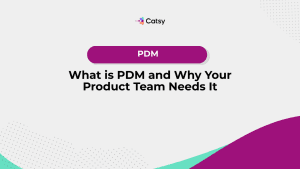PIM Software or a Product Catalog? Everything You Need to Know About Customer-facing Product Content

In this Article
Customer-facing content is the essence of an outstanding customer experience. The purpose of enriching product data into compelling content is to make it customer-focused. In other words, it means enabling prospects to understand your products’ value for them. But what is the best way to manage and share customer-facing content that inspires action? Should you use PIM software or product catalog?
Product catalogs are commonly said to be making a comeback. But the truth is, they never really left. As for PIM software, the ecommerce SaaS has experienced a boom in the past decade that is only projected to grow further. Both offer many advantages for businesses, but how can you choose the best way to organize, create, and publish your customer-facing product content to maximize sales?
In this article, we present a thorough guide to customer-facing product content. Keep reading to know how to optimally deliver high-quality data and content that meets business needs while avoiding overhead costs and inefficiencies.
PIM Software or Product Catalog: How to Manage Customer-facing Content
Behind the scenes, managing product data can become chaotic. However, that doesn’t mean it has to show up that way on the front end. Customer-facing content is what is most important since it speaks to the audience directly.
What is customer-facing product content?
Customer-facing content provides all elements of a product. Attributes, descriptions, images, assets, and anything that the customer (or prospective customer) interacts with head-on. The content that shoppers will eventually use to drive their buying decisions is the result of the enrichment and enhancement of raw data.
Subsequently, it only makes sense that companies must first research extensively their target audience. That intel can then inform their content. Everything from descriptions to titles, keywords to images must be tailored to the audience. The most effective content is that which is focused on the potential customer or end-user, not the brand.
So what does it mean to focus the content on the customer? Because this content will land straight in their hands, it’s important that the language represents the ideal customer.
After all, customers will read the content to learn more about your products.
Therefore, it must embody the following aspects.
- The content must answer their questions.
- It builds confidence in the item, as well as the customers’ confidence in themselves to make an informed buying decision.
- The content should be actionable. In other words, it prompts frictionless conversions or sends customers to points of sale.
Without these factors, content may lack strategy or value. A disconnection between the content and the customer can be undeniably evident. By making the customer the central core of the content, you can target the messaging accordingly.
When drawing up your content strategy, no matter your mode of publishing or sharing, consider the following tips to guide you.
Know your Audience
To reiterate this critical point, knowing your audience is the first step to customer-facing content. Complete knowledge of your target audience means compiling all descriptors of your average ideal buyer.
Ages, locations, other demographics, motivations, challenges, concerns, and analytics on behavioral patterns should all factor in. They all play a part in how likely a person is to buy from a brand. So naturally, they should offer inspiration for the context of the content.
Naming a product’s features is relatively useless when trying to persuade a shopper. Only when you point to specific uses or speak to the ideal buyer’s motivation or problem they want to solve does it begin to click. In some cases, you might point out a hidden benefit they never considered.
Understand Buyer Journey
Alongside your customer profile, mapping the journey of the eventual buyer across your channels helps further improve your content. No matter where your content is published, it requires in-depth research of key points down the sales funnel. When you know from where customers come and on which pages or content pieces they are sold, you can meet them halfway.
Understanding the buyer journey helps makes content contextual on another level. It increases organic traffic when you can pinpoint entry points of high potential. Then, you can devise that content accordingly. Making content relevant to the audience at every point of the journey is critical for a comprehensive customer-facing content strategy.
Focus Your Messaging
Let’s talk about brand messaging. It’s critical that all content on any platform conveys a strong, sound brand presence. However, it’s easy to confuse brand messaging with trying to convey the fine points of the brand and its items. However, customer-facing content must serve the audience the potential value of the item.
A better strategy is to maintain balance. Keeping customer-centric messaging level with that of the brand is key. The customer should always be front-of-mind. Ensure that all content, copy, descriptions, and specifications relating to them in some way. Always pain product information with its relevant use or clear advantage to the end-user.
As a result, this keeps the messaging focused. Every sentence has a purpose. This is the content for which people search.
Of course, these tips simply create the overarching theme or brand message for the body of your content. But of course, when it comes to the fundamental ingredients – product data – there must be a system of organization that allows you to easily use it to author content.
The additional management of assets critical to the product experience is also important to consolidate. This brings into question how to most optimally manage product content from infancy to completion and publication.
How to Best Share Customer-facing Product Content
Of the variety of ways of marketing and sharing information, it’s all goes back to how a business manages its product database. To that end, businesses can either PIM solution or product catalog.
It’s important that, whether you use product information management software or product catalog, your customer-facing content is well equipped to meet customers where they are. The question remains, with which tool can you best do that? PIM software or catalog? Let’s find out.
PIM Software or Product Catalog: How to Choose the Best Way of Publishing
EIther PIM software or product catalog are excellent avenues for delivering customer-facing content. PIM manages product data and content enrichment by way of a multifunctional database. Product catalogs are age-old means of delivering content to drive sales, originally through print and now online or digitally. Both carry much weight in terms of their success and influence on customer decisions.
But if you’re on the fence about which one does the better job or meets your business needs better, here’s an in-depth view of each other.
What is a product catalog?
A product catalog is a type of marketing material that, traditionally print, doubles both as a database of sorts for the business as well as customer-facing collateral.
A catalog is a way for businesses to gather their items together in one place. For many, it doubles as an organizational method, as a database for operational purposes. Of course, it also doubles as marketing collateral, providing an excellent vehicle for customer-facing content.
Product catalogs come in a variety of forms. There are PDFs, interactive digital catalogs, flipbooks, and online catalog websites with shopping cart functionality. Catalogs are incredibly flexible, allowing businesses to use them for a variety of uses. They’re great for larger, B2B suppliers or manufacturers who need to continually update or add to their offerings.
The Purpose of Product Catalog
At a glance, catalogs deliver information that customers must see. A catalog’s function can be condensed to these three uses.
- Reference material
- Attracts audience
- Brand identity
Products catalogs can become reference books, an encyclopedia (depending on the number of items) that businesses can turn to for quick information. For example, sales teams have catalogs at their disposable to find the right content swiftly. Marketers use it through demos; partners, resellers, vendors use the catalog to get and share details. On top of that, they help businesses develop new items or marketing strategies.
The most common reason businesses use catalogs, be it online or print is to attract new customers. Print catalogs have traditionally come with mail-order forms so customers can buy products directly. Today, the ability to access the online store after engaging with a catalog makes the sales process more seamless.
A well-designed catalog hones in on brand identity. Unless a store website or online listings, product catalogs tap into effective design and branding elements to create a compelling experience. This is especially the case when you build a name for yourself base on consistent brand messaging across all catalogs you publish.

Elements of a Product Catalog
While similar to online product listings, catalogs are more complex in how they display items. The value of the catalog is in how they showcase products aesthetically.
As such, there’s more to go into creating a catalog, no matter its function. An electronic product catalog conventionally contains some or all of the following elements.
- Product descriptions
- Attributes
- Specifications
- Quality images
- Design
- User-friendly interface
- Page layout
- Call-to-actions
In some cases, catalogs are a more extensive project. Compared to standard ecommerce marketplaces and pages, while the elements remain the same, the differences lie in the delivery. The pressure to design format a catalog effectively is higher stakes.
In some cases, a catalog management system is necessary to ensure quality and accuracy.
What is catalog management?
Although digital catalogs require less maintenance relative to their print counterparts, proper management is still necessary. Since the key benefits of online catalogs are their efficiency, time-saving accuracy, and reproducibility, it’s critical that businesses create a system.
Catalog management systems are software or processes that streamline the catalog creation process. Front-facing catalogs need an optimal, organized backend that enhances catalogs. In a way, the catalog management system is similar to a product information management system.
Why are product catalogs important?
Catalogs are not just for administrative business processes. They are also for meeting customers where they are. In ecommerce, catalogs serve several critical functions. With digital and web catalogs easily findable on search engines, They drive brand awareness.
Catalogs have the potential to be incredibly interactive, linking back to pages so customers can purchase directly. More than ads or an online product database, catalogs are enhanced collateral that promotes a brand’s authority.
As a part of an omnichannel marketing strategy, both digital and print catalogs provide an entry point for new customers.
If published as print catalogs, they can reach customers directly via their mail. When distributed in-store, they become a physical momento that people can turn to later on. For the less digitally savvy customer, catalogs offer a quality, page-flipping experience that strengthens the brand’s authority in the industry.
Top Benefits of Online Catalogs
- Multifunctional
- Quick Time-to-market
- Improve retail partnerships
- Reduced costs
- Lead generation
- Multichannel marketing
- Increased engagement
Multifunctional Purposes
Online and electronic catalogs can be used for a majority of reasons, from marketing to sales, customer service to sharing data with e-retail partners. Catalogs can be shared with both business partners and online platforms. They can also be an asset for sales and customer service teams to better find items instead of searching through hundreds of offerings. Finally, of course, the door to creating print catalogs is not closed either.

Quick Time-to-market
Compared to print catalogs, online or digital catalogs are relatively much faster to process and update. In many cases, businesses with interactive catalogs can publish data in real-time, which can be useful in the case of pricing or promoting items with specifications that change often.
Improve Retail Partnerships
In a lot of cases, retail partners or B2B customers may prefer a visual catalog over a complex spreadsheet of data. Online catalogs allow flexibility in sharing in the preferred format with distributors or retailers.
Reduced Costs
Online catalogs are all-around cost-saving compared to print and other heavier collateral or marketing strategies. Businesses are able to save resources, especially since most of the tools required for creating a digital catalog are accessible – it’s all digital and in-house, after all.
Businesses can promote items that may change or update frequently. There‘s no need for publishing machinery, paper costs, color and ensign costs, etc.
Lead Generation
Online catalogs, especially on the web, improve SEO. they offer another way to gain traction organically, increasing brand awareness through search engines. While print catalogs have always been specific and customer-focused, catalogs make products available to a larger audience.
Even more important that print catalogs cannot do is the power to track analytics. Clicks, conversions, engagements can all be seen with digital catalogs. This allows you to continually improve marketing efforts and catalog usability.
Multichannel Marketing Strategy
Catalogs are effective for displaying items and increasing interest in product lines and demands as a part of a multi-channel marketing strategy. While in many cases static, digital catalogs have the ability to be quickly disseminated across multiple platforms.
With so many audiences on a variety of entry points, devices, social media platforms, sites, and ecommerce marketplaces, catalogs open up the doors across and between platforms. Furthermore, it costs less to publish and share catalogs while vastly enhancing brand awareness.
Increased Engagement
Compared to online listings, catalogs are more visually pleasing and engaging. They display products in a creative manner, allowing s brands to boost their merchandising strategy. With opportunities to cross-sell and upsell, catalogs overall create an environment for more activity.
Many digital catalogs can be interactive, with videos, images, links to buy directly, or go to social media or web pages. Customers are able to navigate by category, making it easier to sift through thousands of items, if that is the case.
Benefits of Print Catalogs
Back before ecommerce, how do you think businesses kept track of their offerings? Print catalogs used to be a repository for products. Over the years, they became a powerful marketing and sales tool. While less common today, print catalogs continue to be a method of differentiating brands from the many.
Prints catalogs come with the following advantages.
- Influential
- Brand awareness
- Drive action
- Direct engagement
Influential
Surprisingly, catalogs continue to have a peculiar influence. According to the U.S. Postal Service, 75% of people find that catalogs inspire more interest in the retailer’s items. More than eight out of 10 said they have purchased an item after seeing it in a catalog. Print continues to be strong in directing customer behavior. More so than television or digital marketing, catalogs provide a tangible, active reminder of your brand in prospects’ very own homes.
Brand Awareness
While brands send print catalogs to those who already expressed interest in them, print catalogs are also important for building awareness. With the print catalogs’ emphasis on design, aesthetic presentation, and presenting products visually, it encapsulates the brand image in one booklet. When situated in stores or landing in mailboxes, print catalogs offer a break from overwhelming digital media.
Direct Engagement
The online world is teeming with distractions. Many times, all the information and advertising attempts can become a buzz in the background. Print catalogs break away from the humdrum directly engaging with customers.
Get rid of the idea that it is an outdated, ineffective approach – it’s just the opposite. Direct mail allows you to target your market with precision. You can also reduce mailing costs by targeting distributions to specific consumer criteria. When people interact with a physical catalog in front of their eyes, it’s more memorable. It drives action, produces a stronger imprint on one’s memory. Even if there is disinterest at first, a catalog tends to sticks around for around 20 days, leaving plenty of time for prospects to flip through when they are bored.
What are the Challenges of Online or Print Catalogs?
You might be sold by the print catalog’s benefits of the online catalog’s immense efficiency and lower costs. However, many challenges arise without a proper catalog management system or strategy.
Misplaced and haphazardly organized data can lead to more costs down the line when fixing catalog errors. For print, this is even more critical, and a business’ lack of trust in their own information accuracy can lead to a catalog going back and forth between proofing and approval.
Creating a catalog requires loading product information (name, price, SKU data, description, quality photos, variant options, categories, etc.) painstakingly onto whatever design software you use. Undoubtedly, the process is time-consuming.
Importing data by Excel or spreadsheet or other documents takes time. Other means of doing so include integrating data files via an expensive external system. Ecommerce platforms pose an opportunity to simply use product information and management tools, but such tools can be lacking. Furthermore, no matter what you do, it will entail manually inputting or editing data onto the digital catalog interface.
This is where businesses can stand to benefit from PIM solution.
PIM Software or Product Catalog: What is PIM?
PIM, product information management, is a database that draws all raw data into one cloud-based storage system. With the data, it cleanses and standardizes into actionable data ready to enrich and use to author content.
Moreover, to consider the needs of today’s ecommerce landscape, PIM also holds assets like visuals, images, and other critical marketing components that enhance the shopping experience. Pushing it all out allows for the best customer-facing content, with less time, effort, and costs. It can navigate multiple channels and allows businesses to keep track of all info updates.

Top Benefits of PIM Software
While not comprehensive, the following is a list of some of the most fundamental advantages of PIM software.
- A single view of product data
- Data cleansing
- Quick updating
- Robust backend
- Multichannel syndication + multipurpose
- Catalog templates/design framework
A Single View of Product Data
The most prominent functionality is this: centralization. It provides a broad, detailed overview of a business’ lifeblood – all products and their attributes and tagged information and assets. Everything you may need for your ecommerce business.
PIM is a centralized platform that fuels high-quality customer-facing content. After all, you can organize things without first gathering them together. Think of the last time you organized a large room. PIM draws all data together so you can inspect and fix any errors hanging around. When data is in one place, all employees can access it for marketing purposes, prepare data for customer-facing content by enhancing attributes. It allows for authoring straight onto the PIM platform before publishing on other sites or marketplaces (or catalogs).
As you can imagine, PIM’s centralization feature highlights consistency.
Data Cleansing
Alongside centralization, PIM standardizes and cleanses all data automatically. supplier data isn’t always top-notch after all. Nor does it often match a business’ personal brand message or standards. By configuring these custom settings, PIM enhances all data into understandable, consistent terminology.
PIM data maintains accuracy. Product information can remain the same across all catalogs or platforms. After all, customers value a brand’s consistency on a subconscious level. When all data is continuously correct and maintain a similar brand image no matter what, it increases confidence in your offerings.
Quick Product Updating
Whether there is an improvement, update, or an error to be solved, updating is a regular happening in ecommerce. PIM allows for smooth product information updates across all platforms. This helps save time when dealing with data errors. It also makes update workflows easier to publish. Overall, PIM reduces time-to-market from product conception to content enrichment.
Robust Backend System
The customer-facing side of things is fueled by a well-oiled backend machine. With the strong structure that PIM provides of your organization and operations, it’s translate to content that meets customers adequately.
Businesses better manage their product organizational framework within PIM. With highly detailed metadata, you can build a robust taxonomical system that allows employees to best utilize all assets. In action, it enhances the strategizing process for creating customer-facing content. When it comes to online customer-facing product pages and catalogs, PIM ensures customers can find products fluidly based on their specific needs. With proper and comprehensive categorization, it’s easier for customers to inspect and analyze products without wasting time exploring.
Multichannel Sharing
A quick time-to-market is high value in today’s fast-paced ecommerce age. With more channels available, speed is critical to increasing sales. With PIM, it’s easier to meet not only b business needs for speed but also the customers’.
PIM facilitates multichannel publish features that make uploading and updating product information across platforms efficient. Content reaches customer-facing interfaces faster, without sacrificing quality. On top of channels, PIM allows for the management and sharing of other marking and informational collateral. Spec sheets, product sheets, banners, images, videos, you name it.
Moreover, sales and customer service teams can directly provide customers the right content at the right time. Employees are able to retrieve product information quickly through PIM. Thus, they are equipped to answers questions instantly.
Catalog Templates
Alongside all other features, many PIM systems also dabble in the art of catalogs. With integrated design software or API connection with software like Adobe InDesign, it’s more streamlined to create catalogs.
All you’d have to do is propagate the product content already stored and ready onto the catalog template. With collaboration between design, marketing, and copywriting teams, it’s seamless processes to create quality catalogs. Include all products and even link to online product pages for interactive catalogs if need be. Such a framework meets high customer expectations.
To piggyback off the last point, a PIM that has catalog creation and management capabilities is a superior option.

PIM Software or Product Catalog: Best of Both Worlds
For customer-facing content, it’s better to use a multichannel approach that allows for both to work in tandem. That’s why implementing a PIM that bridges the gap to not only other channels but also catalog creation offers a seamless option. If it exists, why should you have to choose between one?
Manage a large product catalog
PIM becomes a comprehensive, consolidated database that fuels accurate, detailed product catalogs. Everything you need to add to your product catalog exists in PIM. it’s easier to find products and attributes easily and attach product images as well.
No matter how large your product catalog may be, PIM’s tagging system makes filtering and searching for the right products faster. Publishing product catalogs and creating catalogs becomes a breeze, with little time spent searching.
Syndicate to multiple channels simultaneously
A PIM with catalog management capabilities achieves the need or desire for businesses to create a multichannel strategy. simultaneously, it establishes a system of records for organizing and enriching product content for customer-facing platforms. For example, PIM like Catsy doubles as a catalog management tool while providing a centralized. Its robust, flexible API connects to external publishing platforms, including product catalog creation software tools.
Collaboration between multiple departments
Wit hall product information in one place, no team has to be divided. Product data files and spreadsheets no longer need to be siloed between critical departments. After all, for all customer-facing content, be it online product pages or product catalogs, multiple teams work together.
PIM emphasis strong collaborative communication, connecting design, marketing, copy, sales, and photography teams. Together, it boosts productivity, allows access to all necessary product content for creatives who need it.
Create catalogs smoothly from product data on PIM
With PIM, it’s possible to transfer all your business’ product data straight onto a catalog template. With the design elements ready to use, you can save a ton of time. When it comes to updating data, this is essential, allowing you to create new, up-to-date catalogs as needed.
Speaking of on-demand catalog creation, it’s also easier to target the catalog to the buyer persona. Or, if you are a B2B company with close one-on-one customer relationships, you can tailor a catalog to a single client. Use only the products and data you need to save time on both ends. It’s especially helpful for businesses with a huge catalog selection.
Otherwise, creating a catalog is simple no matter the purpose – selection product line, new product introductions, a huge annual catalog, or a general web catalog. Create whenever you want with less risk of inaccurate data or mistakes.
PIM like Catsy doubles as a catalog management tool while providing a centralized database to store product data.
Final Words
Customer-facing content must provide value, informing the customer of the detail they need. To reach a buying decision, it’s critical that the content that meets the customers’ eyes directly is suited to thier specific context, preferences, and concerns. It all starts with how a business maintains and enriches its product information.
While product catalogs and PIM software are two of the top modes of publishing customer-facing content, it’s critical to strategize.
With a product catalog, you can create navigable, user-friendly, and traditionally formatted collateral for a variety of uses. Be it sales, marketing, or close B2B relationships catalogs come in handy.
With PIM, it’s possible to manage a centralized database of product information and all other assets to publish on multiple platforms. While multifunctional, PIM doesn’t lack in the catalog department. All things considered, a PIM is equatable to a catalog management system. Head to head, PIM software or product catalog, PIM is the clear winner. It improves backend end and customer-facing content on all fronts, including catalog templates.
Catsy PIM and DAM systems offer such a robust solution on all fronts: product data management, organization, digital asset management, and catalog management. Check out a live demo of Catsy PIM and DAM to see how it works or visit the website for more information.
PIM software stands for Product Information Management software, which is a centralized system for managing and organizing product data. It allows businesses to store and manage information such as product descriptions, images, specifications, and pricing in one place. On the other hand, a product catalog refers to the collection of product information presented to customers, whether in print or digital format. While a product catalog can be a part of PIM software, PIM software provides broader functionality beyond just catalog creation.
PIM software offers several benefits for managing customer-facing product content. It provides a centralized repository for storing and updating product information, ensuring consistency and accuracy across all channels. It enables businesses to efficiently create and manage multiple versions of product catalogs for different regions or target audiences. Additionally, PIM software facilitates easy collaboration among team members involved in content creation and ensures faster time-to-market for new products or updates.
There are scenarios where a product catalog might be a more suitable choice than PIM software. If a business has a small number of products with simple attributes and doesn’t require frequent updates, a product catalog can be a cost-effective solution. Similarly, if the primary focus is on producing printed catalogs or specific marketing materials rather than managing the entire product data lifecycle, a product catalog might suffice. However, if the business deals with a large number of products with complex attributes, multiple channels, and frequent updates, PIM software would provide more comprehensive functionality.
To choose the best way of publishing customer-facing product content, businesses should consider their specific requirements and goals. Firstly, they should assess the complexity of their product data and the need for centralized management. If the data is extensive and requires frequent updates, PIM software would be a better choice. Secondly, businesses should evaluate the target channels they need to publish the content on. If they require omni-channel capabilities, PIM software can offer more flexibility. Lastly, businesses should consider their team’s collaboration needs and scalability requirements to make an informed decision.
Yes, businesses can benefit from using both PIM software and a product catalog in conjunction. While PIM software provides robust data management capabilities, a product catalog focuses on presenting the information in a customer-friendly format. By integrating the two, businesses can leverage the centralized data management capabilities of PIM software while using the product catalog as a customer-facing touchpoint. This combination allows for efficient content creation, updates, and consistency across channels, enhancing the overall customer experience.




